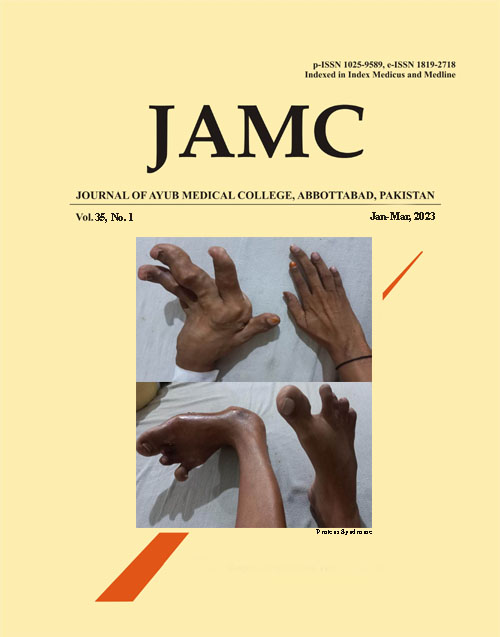EFFICACY OF INJECTING INTRA-VITREAL MOXIFLOXACIN IN ACUTE POST-OPERATIVE ENDOPHTHALMITIS
DOI:
https://doi.org/10.55519/JAMC-01-11011Keywords:
acute post-operative endophthalmitis, intra-vitreal moxifloxacin, vancomycin, ceftazidime, efficacyAbstract
Intra-vitreal Vancomycin (IV-V) and ceftazidime (IV-C) are commonly in the treatment of acute post-operative endophthalmitis. But there are suboptimal responses in some cases due to the emergence of antibiotic resistant micro-organisms. Moxifloxacin is a wide range antibacterial drug that is available as an eye drops for topical use for different types of ocular infections including post-operative endophthalmitis. But it has not been explored extensively as an intra-vitreal drug for post-operative endophthalmitis. We unveiled its broad spectrum anti-bacterial properties by giving it as an intra-vitreal route of delivery so to see its efficacy in post-operative endophthalmitis case. A 65 years old diabetic male presented with acute painful loss of vision in his right eye 2 days following his cataract extraction with posterior chamber intraocular lens implantation (PC IOL). His visual acuity (VA) on presentation was just counting finger close to eye. Slim lamp examination (SLE) revealed swollen lids, discharge in the inferior conjunctival fornix, conjunctival redness and chemosis, hazy cornea, fibrinous exudate in AC along with hypopyon, there was marked vitritis with yellowish fundal glow apparent. The patient was injected with intra-vitreal moxifloxacin 0.5mg/0.2 ml, along with topical and oral antibiotics in combination with steroids. VA reached to 6/24 and follow-up at 4th week didn’t show any of intra-ocular inflammatory changes on SLE. Intra-vitreal moxifloxacin mono-therapy is a better substitute to combination of vancomycin and ceftazidime due to its broad-spectrum coverage in acute post-operative endophthalmitis.References
Irma E, Edwar L, Setiabudy R, Kurniawati A, Kodrat E, Susiyanti M. Comparing the effectiveness of intravitreal levofloxacin and ceftazidime in experimental Pseudomonas aeruginosa endophthalmitis. EC Ophthalmol 2018;9(4):164–71.
Niazi MK, Khan MD, Arain MA, Adeeb L, Yasir S. Effect of intravitreal moxifloxacin in acute post traumatic endophthalmitis. Am J Med Case Rep 2014;2(2):39–40.
Jacobs DJ, Grube TJ, Flynn Jr HW, Greven CM, Pathengy A, Miller D, et al. Intravitreal moxifloxacin in the management of Ochrobactrum intermedium endophthalmitis due to metallic intraocular foreign body. Clin Ophthalmol 2013;7:1727–30.
Barry P, Baumann WB, Pleyer U, Seal D. ESCRS guidelines on prevention, investigation, and management of post-operative endophthalmitis. The European Society for Cataract and Refractive Surgeons; 2007.
Kuhn F, Gini G. Ten years after... are findings of the Endophthalmitis Vitrectomy Study still relevant today? Graefes Arch Clin Exp Ophthalmol 2005;243(12):1197–9.
Blondeau JM. Fluoroquinolones: mechanism of action, classification, and development of resistance. Surv Ophthalmol 2004;49(Suppl 2):73–8.
Yağci R, Oflu Y, Dinçel A, Kaya E, Yağci S, Bayar B, et al. Penetration of second, third and fourth generation topical fluoroquinolone into aqueous and vitreous humour in a rabbit endophthalmitis model. Eye (Lond) 2007;21(7):990–4.
Gao H, Pennesi ME, Qiao X, Iyer MN, Wu SM, Holz ER, et al. Intravitreal moxifloxacin: retinal safety study with electroretinography and histopathology in animal models. Invest Ophthalmol Vis Sci 2006;47(4):1606–11.
Kernt M, Neubauer AS, Ulbig MW, Kampik A, Welge-Lüssen U. In vitro safety of intravitreal moxifloxacin for endophthalmitis treatment. J Cataract Refract Surg 2008;34(3):480–8
Published
Issue
Section
License
Journal of Ayub Medical College, Abbottabad is an OPEN ACCESS JOURNAL which means that all content is FREELY available without charge to all users whether registered with the journal or not. The work published by J Ayub Med Coll Abbottabad is licensed and distributed under the creative commons License CC BY ND Attribution-NoDerivs. Material printed in this journal is OPEN to access, and are FREE for use in academic and research work with proper citation. J Ayub Med Coll Abbottabad accepts only original material for publication with the understanding that except for abstracts, no part of the data has been published or will be submitted for publication elsewhere before appearing in J Ayub Med Coll Abbottabad. The Editorial Board of J Ayub Med Coll Abbottabad makes every effort to ensure the accuracy and authenticity of material printed in J Ayub Med Coll Abbottabad. However, conclusions and statements expressed are views of the authors and do not reflect the opinion/policy of J Ayub Med Coll Abbottabad or the Editorial Board.
USERS are allowed to read, download, copy, distribute, print, search, or link to the full texts of the articles, or use them for any other lawful purpose, without asking prior permission from the publisher or the author. This is in accordance with the BOAI definition of open access.
AUTHORS retain the rights of free downloading/unlimited e-print of full text and sharing/disseminating the article without any restriction, by any means including twitter, scholarly collaboration networks such as ResearchGate, Academia.eu, and social media sites such as Twitter, LinkedIn, Google Scholar and any other professional or academic networking site.









